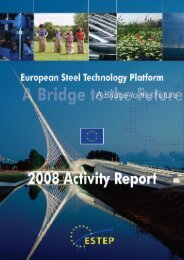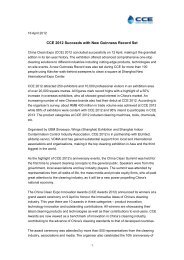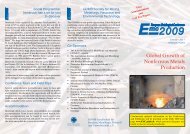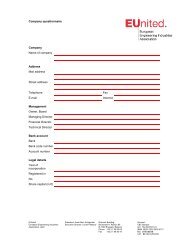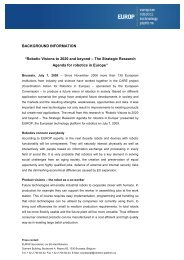EUROP Position Paper (PDF) - EU-nited
EUROP Position Paper (PDF) - EU-nited
EUROP Position Paper (PDF) - EU-nited
You also want an ePaper? Increase the reach of your titles
YUMPU automatically turns print PDFs into web optimized ePapers that Google loves.
<strong><strong>EU</strong>ROP</strong> <strong>Position</strong> <strong>Paper</strong><br />
on the Green <strong>Paper</strong> of the European Commission<br />
“From Challenges to Opportunities: Towards a Common Strategic<br />
Framework for <strong>EU</strong> Research and Innovation Funding"<br />
Mai 2011<br />
<strong><strong>EU</strong>ROP</strong> – European Robotics Technology Platform<br />
c/o <strong>EU</strong><strong>nited</strong> Robotics, Diamant Building, Boulevard A. Reyers 80, 1030 Brussels, Belgium<br />
Tel. + 32 2 706 82-22, Fax + 32 2 706 82-23
1. Introduction<br />
In February 2011, the European Commission presented a Green <strong>Paper</strong> on the<br />
organisation of research and innovation after the Seventh Framework Programme<br />
and officially launched a public consultation and discussion with stakeholders.<br />
In this position paper <strong><strong>EU</strong>ROP</strong>, as one of the 36 ETPs, presents its views and<br />
expectations regarding the Common Strategic Framework (CSF). The position<br />
paper is based on work developed over the past few years within the Platform as<br />
well as discussions within the working group sessions at the European Robotics<br />
Forum 2011, which was held from 6-8 April in Västerås / Sweden and brought<br />
together over 335 roboticists from all over Europe. The event provided an excellent<br />
opportunity to have some wide, membership based consultation that culminated<br />
into this position paper.<br />
Robotics, while not currently a major industry by itself, is a key enabler that<br />
underpins manufacturing competitiveness and is increasingly supporting the ability<br />
to find innovative solutions for many of the major societal challenges. In terms of<br />
manufacturing competitiveness, robotics uniquely underpins issues regarding<br />
flexibility, mass customisation, sustainable production, retention of employment<br />
(particularly when related to an aging population), automation within SMEs and<br />
new business model support. Outside of the factory service robots are enhancing<br />
service delivery efficiencies, providing solutions for many societal challenges (such<br />
as affordable healthcare). Therefore it is vital that Europe maintains a strong<br />
position in robotics technologies and robotics applications.<br />
2. Towards Innovation<br />
As an industrially led Platform, <strong><strong>EU</strong>ROP</strong> welcomes the shift of emphasis for the next<br />
Framework Programme from primary RTD focus to innovation.<br />
To reach this goal, industrial members wish to see more attention on market<br />
relevance, (expected) results, technology transfer to industry and economic impact<br />
of research projects during the whole funding process – starting from overall<br />
strategy and budget distribution, Work Programmes, calls and evaluation of project<br />
proposals and project evaluation. Industrial participation in the project and/or<br />
<strong><strong>EU</strong>ROP</strong> is enabled by euRobotics Action, funded by the European Commission within the 7th<br />
Framework Programme (FP7-ICT-244852; 01/2010 – 12/2012)<br />
http://www.eurobotics-project.eu<br />
page 1 of 13
industrial commitment will guarantee the market relevance of the research and the<br />
uptake of the results. Currently, the industrial participation in research projects<br />
funded by the European Commission lies at approximately 30 % - this needs to be<br />
enlarged, if industry benefit is to be derived from the research programme.<br />
From the robotics industry point of view many of the current academic led <strong>EU</strong><br />
projects lack a realistic view of industrial needs and market relevance. While<br />
<strong><strong>EU</strong>ROP</strong> members acknowledge the importance of research excellence in order to<br />
extend the future knowledge base and capabilities, industrial members would be<br />
concerned if there were an emphasis on a science-oriented and long-term focus<br />
within the CSF robotics funding profile at the expense of actions aimed at more<br />
focussed industrially-driven research that will provide more immediate impact.<br />
SMEs in particular would welcome more market-oriented research, since SMEs –<br />
due to their financial and resource constraints - are only willing to invest money<br />
and time in research that is expected to pay-off in the short to medium term, which<br />
means will end up in products they can sell and/or use. Hence, the shift towards<br />
innovation will increase the participation of SMEs in the Framework Programme.<br />
3. Testing and validating research results<br />
The full innovation cycle (from research to market uptake) should be covered by<br />
the upcoming Common Strategic Framework Programme (CSF). Follow-up<br />
projects / funding might be necessary after the end of the research project before<br />
the innovation process is completed: testing / validating, linking to other initiatives<br />
(such as the lead-market initiative, and European Investment Bank loans),<br />
promoting and marketing of the technology readiness in general, covering<br />
legislative aspects, finding venture capital, market introduction, etc.<br />
Very often in robotics, many practical problems appear only during real-world<br />
experimentation. Through testing of research results and pilot projects in strategic<br />
areas, the researchers become aware of new problems they need to solve before<br />
the technology / product is fit for the market. Therefore, <strong><strong>EU</strong>ROP</strong> members are<br />
looking for more projects with applied research, including testing and validating<br />
research results in the real world. This will help bridging the “valley of death”<br />
between end of research and commercialisation.<br />
<strong><strong>EU</strong>ROP</strong> is enabled by euRobotics Action, funded by the European Commission within the 7th<br />
Framework Programme (FP7-ICT-244852; 01/2010 – 12/2012)<br />
http://www.eurobotics-project.eu<br />
page 2 of 13
4. Including short-time, smaller-scale projects (“ECHORD”-type)<br />
<strong><strong>EU</strong>ROP</strong> members see the need for more smaller-scale and more agile projects.<br />
One model that can be built on within the CSF is the ECHORD experiments<br />
project. “ECHORD” (European Clearing House for Open Robotics Development,<br />
FP7-231143) is an integrating project aimed at strengthening the cooperation<br />
between scientific research and industry in robotics. In the context of ECHORD,<br />
small-scale projects, so-called “experiments” are conducted, which use state-of-the<br />
art robot equipment. Within ECHORD research institutes and industry are invited to<br />
carry out experiments which address specific challenges that industry is currently<br />
facing. Experiments have a limited time frame, a set financial budget, streamlined<br />
administrative requirements and most importantly, the processes for carrying out<br />
the experiments are simple and quick. From this innovative concept which focuses<br />
on Europe’s current industrial needs, <strong><strong>EU</strong>ROP</strong> anticipates exceptional knowledge<br />
transfer between industry and academia that will ultimately increase innovation and<br />
European competitiveness in the field.<br />
The European robotics community would appreciate the seamless continuation of<br />
ECHORD.<br />
The introduction of a new funding instrument in the Common Strategic Framework<br />
Programme, modeled after ECHORD’s design, would significantly facilitate the<br />
whole funding process of the small-scale experiments. It has been quite<br />
challenging for the ECHORD coordinator to start the first rounds of experiments<br />
due to the fact that the current project types and funding instruments (IP, STREPs,<br />
CSA) simply were not set up for small-scale experiments funded by the project<br />
itself. This has caused bureaucratic hurdles – which could be easily removed if the<br />
EC made provisions for this very promising new typed project in the future.<br />
<strong><strong>EU</strong>ROP</strong> is enabled by euRobotics Action, funded by the European Commission within the 7th<br />
Framework Programme (FP7-ICT-244852; 01/2010 – 12/2012)<br />
http://www.eurobotics-project.eu<br />
page 3 of 13
5. Towards Simplification and Flexibility<br />
All <strong><strong>EU</strong>ROP</strong> members agree: the preparation and selection process needs to be<br />
simplified. It takes much too long from the moment a project idea is born until the<br />
project starts.<br />
In general, proposal writing is very time consuming, in particular if you take into<br />
account that the success rate of a submitted proposal lies only at 18 % (on<br />
average across all FP7 programmes).<br />
The industrial <strong><strong>EU</strong>ROP</strong> members look for more focused calls: the calls should be<br />
structured in relatively narrow industrially-relevant areas to prevent<br />
oversubscription. This would attract a higher percentage of industry participation,<br />
particularly SMEs, in the calls and would lower the application rate, which would<br />
also speed the evaluation process. <strong><strong>EU</strong>ROP</strong> therefore recommends having<br />
dedicated and focused calls for industry.<br />
A two-step approach could also simplify the process:<br />
Step 1: a short summary of the goals, planned approach, funds required,<br />
expected results and economic relevance, as well as a short description of<br />
the involved partners. In total 10 pages should suffice.<br />
Step 2: only for those project proposal that are positively reviewed, a<br />
detailed description of the work packages and deliverables should be<br />
elaborated.<br />
This would not only lessen the required efforts of proposers and reviewers, but - if<br />
managed properly – would also speed-up the evaluation process and lower the<br />
hurdles for participating in research funding, which would hence encourage new,<br />
innovative organisations and SMEs to participate in the Framework Programme.<br />
During the project run-time, the administrative burden needs to be lowered:<br />
Financial guidelines are too complicated and complex! On a national level.<br />
e.g. in Germany, they are much shorter and easier.<br />
Reporting and financial administration is too time consuming for both,<br />
involved project partners as well as project officers. The administrative<br />
burden should be lowered and moved towards a more result-oriented and<br />
<strong><strong>EU</strong>ROP</strong> is enabled by euRobotics Action, funded by the European Commission within the 7th<br />
Framework Programme (FP7-ICT-244852; 01/2010 – 12/2012)<br />
http://www.eurobotics-project.eu<br />
page 4 of 13
trust-based partnership between the European Commission and industry.<br />
Bear in mind that industry, with the actual funding rate of 50%, also takes a<br />
risk and hence has an interest in getting results out of the research project.<br />
<strong><strong>EU</strong>ROP</strong> members also require more flexibility during the project run-time with<br />
regard to project objectives, budget distribution and even changes of project<br />
partnership. With the rate of technology change in robotics, quite a lot can change<br />
from project submission to project completion and it is important to ensure that<br />
innovation projects remain relevant and adapt to technology and market<br />
developments.<br />
6. Enhanced communication<br />
From <strong><strong>EU</strong>ROP</strong>’s point of view, enhanced communication is key for bringing the<br />
robotics industry forward! The robotics industry and many other sectors have<br />
described their vision and goals in detail in Strategic Research Agendas and are<br />
ready and willing, to tackle the identified challenges through enhanced<br />
communication and cooperation with the European Commission and other public<br />
funding bodies! Let’s start a regular dialogue between industry, academia, the<br />
European Commission and other funding bodies from the member states. It’s<br />
robotics in Europe that counts!<br />
Robotics research funding is fragmented within the EC. We have the following<br />
bodies dealing with robotics research:<br />
DG INFSO, Unit E5 – as main contact person for robotics<br />
DG INFSO, Directorate F – FET Flagship on Robotics<br />
DG INFSO, Directorate H – service robotics for elderly care<br />
DG INFSO, Directorate G (Factories of the Future PPP)<br />
DG Research, Directorate G (Factories of the Future PPP)<br />
All above mentioned Directorates / Units organise interesting events, hold<br />
consultation meetings with robotics stakeholders and conduct studies. It is hard for<br />
the robotics industry to keep track of all above mentioned initiatives, events and to<br />
maintain contact with all above mentioned directorates.<br />
<strong><strong>EU</strong>ROP</strong> is enabled by euRobotics Action, funded by the European Commission within the 7th<br />
Framework Programme (FP7-ICT-244852; 01/2010 – 12/2012)<br />
http://www.eurobotics-project.eu<br />
page 5 of 13
<strong><strong>EU</strong>ROP</strong>’s industrial membership is mainly based on SMEs. Europe has only<br />
a few major key player robotics: KUKA, ABB AB Robotics, Comau, Reis and<br />
Güdel with around 1000 employees and hence the overall industry does not<br />
have enough manpower to participate in all consultation processes.<br />
<strong><strong>EU</strong>ROP</strong> and the robotics community suffer from this fragmentation. <strong><strong>EU</strong>ROP</strong> would<br />
appreciate if robotics-related research could be centralised in one Directorate only.<br />
The fragmentation of research might lead towards fragmentation of the robotics<br />
community.<br />
7. Enhancing competitiveness<br />
Robotics plays a key role for keeping production competitive and hence makes it<br />
attractive to invest in Europe: It is through robotics and automation that<br />
manufacturing companies can compensate the competitive disadvantage of higher<br />
labour costs in Europe and ultimately retain employment within Europe, albeit with<br />
different, and higher, skills requirements. Outside of factories service robots are<br />
transforming the operations of many sectors and dramatically increasing the<br />
productivity and competitiveness, from agriculture (e.g. milking robots) to energy<br />
(e.g. sub-sea robots).<br />
8. Tackling societal challenges<br />
Robotics is a key element for dealing with societal challenges Europe is<br />
facing:<br />
Creating an energy- and resource-efficient production<br />
Producing "green" products with economies of scale<br />
Creation and retention of equal-opportunity and high-quality employment<br />
Coping with an ageing work-force: keeping the ageing workforce with<br />
valuable work experience in the production process<br />
Providing solutions for elderly care<br />
Protection against external and internal threats to security<br />
Providing environmental monitoring<br />
<strong><strong>EU</strong>ROP</strong> is enabled by euRobotics Action, funded by the European Commission within the 7th<br />
Framework Programme (FP7-ICT-244852; 01/2010 – 12/2012)<br />
http://www.eurobotics-project.eu<br />
page 6 of 13
Robotics can make valuable contributions to the grand societal challenges and<br />
looks forward to an even greater focus on societal challenges in the next<br />
Framework Programme.<br />
However, as mentioned already above: robotics as such is a relatively small<br />
industry and <strong><strong>EU</strong>ROP</strong>, compared to other ETPs, is not driven by big players. Hence,<br />
<strong><strong>EU</strong>ROP</strong> and the robotics industry cannot always keep in constant contact with the<br />
EC regarding the importance of robotics as bigger players do for their respective<br />
fields, e.g. IT industry, automobile industry, manufacturing industry.<br />
9. Recommendations<br />
In summary <strong><strong>EU</strong>ROP</strong> recommends the following:<br />
1. Increase industrial participation in the design of work programmes and<br />
calls<br />
Specific actions should include:<br />
Greater consultation between the ETP and EC regarding the content of<br />
calls, with specific consultation regarding innovations actions within each<br />
call<br />
Greater participation by European industry in the evaluation of industrially<br />
relevant call proposals<br />
2. Increased focus on actions that assist the transfer of ideas into real-world<br />
products and services<br />
Specific actions should include:<br />
Increased focus on market relevance of (expected) results, technology<br />
transfer to industry and economic impact of research projects during the<br />
whole evaluation process<br />
<strong><strong>EU</strong>ROP</strong> is enabled by euRobotics Action, funded by the European Commission within the 7th<br />
Framework Programme (FP7-ICT-244852; 01/2010 – 12/2012)<br />
http://www.eurobotics-project.eu<br />
page 7 of 13
The inclusion of specific project actions including pilot plant and strategic<br />
demonstrator facilities, as well as smaller scale, short term projects such as<br />
those currently addressed within ECHORD.<br />
Greater integration of approach between Research and Innovation<br />
programmes and complementary actions such as Lead Market initiatives in<br />
terms of supported themes and strategic approach.<br />
Support for testing and validating of research results in industrial settings<br />
3. The procedures for administration and management of the calls and<br />
subsequent projects need to be streamlined<br />
Specific actions should include:<br />
The administrative burden of projects within the CSF need to be lowered,<br />
particularly for smaller scale projects<br />
A new funding instrument that allows for more innovative, smaller-scale<br />
projects (such as ECHOR- type projects) needs to be introduced<br />
Time-to-grant needs to be shortened significantly<br />
Project administration approaches needs to be adaptive to support<br />
appropriate flexibility within running projects<br />
Introductions of 2 step-calls should be considered where these can be<br />
implemented in a light and agile manner<br />
4. SME Involvement needs to be broadened<br />
Specific actions should include:<br />
Focus on shorter term, more industrially oriented calls<br />
Consideration should be given to the definition of SME and / or specific<br />
actions / support to encourage participation from mid-capitalisation<br />
companies<br />
<strong><strong>EU</strong>ROP</strong> is enabled by euRobotics Action, funded by the European Commission within the 7th<br />
Framework Programme (FP7-ICT-244852; 01/2010 – 12/2012)<br />
http://www.eurobotics-project.eu<br />
page 8 of 13
5. Establish a central point of contact for robotics within the CSF<br />
As a minimum this should be a single identified point that would handle all<br />
consultation inputs from the industry and be a source of information for<br />
robotics related calls<br />
6. Actions to move best practice from leading edge companies to the much<br />
larger number of smaller manufacturing companies and thereby raising<br />
European competitiveness<br />
Greater emphasis on dissemination actions that increase the outreach of<br />
robotics technologies to new application areas and industries, e.g. through<br />
the use of trade bodies, locals national and regional networks.<br />
<strong><strong>EU</strong>ROP</strong> is enabled by euRobotics Action, funded by the European Commission within the 7th<br />
Framework Programme (FP7-ICT-244852; 01/2010 – 12/2012)<br />
http://www.eurobotics-project.eu<br />
page 9 of 13
ANNEXES<br />
1. About <strong><strong>EU</strong>ROP</strong><br />
<strong><strong>EU</strong>ROP</strong>, the European Robotics Technology Platform, is one of several ETPs<br />
(European Technology Platforms) initiated by the European Commission during the<br />
6 th Framework Programme. <strong><strong>EU</strong>ROP</strong> was founded in 2005 as an industry-led<br />
voluntary network of stakeholders of robotics in Europe. Two SRAs were<br />
developed – the latest version was presented in July 2009. Since then, <strong><strong>EU</strong>ROP</strong><br />
has worked on implementation of the SRA (e.g. through the ECHORD project,<br />
contribution to the roadmap of the Factories of the Future Public Private<br />
Partnership, representation in the “Ad-Hoc Industrial Advisory Group for Factories<br />
of the Future”, Manufuture/EFFRA, Fet Flagship Proposal on Robotics). Together<br />
with its academic sister network <strong>EU</strong>RON, <strong><strong>EU</strong>ROP</strong> has been lately concentrated on<br />
on improving communication between industry and academia and the promotion of<br />
European robotics.<br />
As of today, <strong><strong>EU</strong>ROP</strong> brings together 140 members and cooperation partners, of<br />
which 67 are industrial organizations (of which 53 are SMEs) and 44 are<br />
universities / research centres.<br />
Members’ interest is evenly distributed among the five different robotics fields<br />
(industrial, domestic service, professional service, space and security robotics)<br />
which underlines the fact that challenges, technologies and research needs are the<br />
same for all robotics domains.<br />
<strong><strong>EU</strong>ROP</strong> is currently supported through the euRobotics Coordination funded by the<br />
European Commission under the 7 th Framework Programme.<br />
<strong><strong>EU</strong>ROP</strong> is enabled by euRobotics Action, funded by the European Commission within the 7th<br />
Framework Programme (FP7-ICT-244852; 01/2010 – 12/2012)<br />
http://www.eurobotics-project.eu<br />
page 10 of 13
2. Robotics in Europe - a short introduction<br />
2.1 The robotics market – some figures:<br />
Worldwide in 2010, around 115,000 industrial robots were sold with a value of<br />
6.2 billion €. Including associated systems, the turnover of the robotics industries<br />
were almost 20 billion €.<br />
The robotics industry was hit severely by the worldwide economic and financial<br />
crisis: Compared to 2008, considered one of the most successful years, 2009 had<br />
a decline of 47% (60,000 units). This is the lowest level reported since 1994! In<br />
Europe, sales dropped by 41%. Asia had to cope with a decline of 50%.<br />
Fortunately, the robotics industry is back on a growing path: IFR predicted growth<br />
rates of approximately 10% in 2011 and 2012 for industrial robotics. This<br />
The European robotics industry is in general very well positioned. In the past years<br />
it has gradually reduced its dependence on the automotive industry and its<br />
subcontractors, and has systematically opened up and expanded new fields of<br />
application for robots (e.g. rubber and plastics industry, metal and machine<br />
industry, electronics, food and beverage). In 2010, both the automotive industry as<br />
well as the non-automotive sectors made large investments to optimize their<br />
production processes: 30,000 industrial robots were sold in Europe, 45% more<br />
than in 2009. This is still about 15% lower than the peak levels of 2007 and 2008,<br />
but growth rates are predicted.<br />
In the last 10 years, encouraging signals have come from the service robotics<br />
field. A service robot is used foremost outside the manufacturing field and semi or<br />
fully autonomously provides services to humans. A service robot is usually mobile,<br />
flexible, easy to handle and requires a much closer interaction with humans. A<br />
number of service robots are already successfully operating in the professional<br />
sector, such as medical, logistics and food, as well as in domestic settings for tasks<br />
related to house- and garden keeping.<br />
The statistics divide service robotics in two main categories:<br />
Professional service robots: These are high valuable high tech products like<br />
field robots, milking robots, security robots<br />
<strong><strong>EU</strong>ROP</strong> is enabled by euRobotics Action, funded by the European Commission within the 7th<br />
Framework Programme (FP7-ICT-244852; 01/2010 – 12/2012)<br />
http://www.eurobotics-project.eu<br />
page 11 of 13
Domestic/personal service robots: mass products, low-priced like toy robots<br />
Compared with the operational stock of industrial robots (which is more than one<br />
million), a rather low number of professional service robot units is on the market.<br />
But the potential is tremendous!<br />
According to figures from the IFR Statistical Department in 2009, about 12.900<br />
service robots were put into operation for professional applications (80% of them in<br />
the categories “field robotics” and “defence, rescue and security”) and in the years<br />
2010 – 2013 another 80,000 with a value of 12 billion US $ shall follow.<br />
Figures from the service robots for personal/domestic are higher: in 2009<br />
almost 1 million robots for domestic tasks were sold (vacuuming, floor cleaners,<br />
lawn mowers, pool cleaners and robot companions): In the years 2010 – 2013 11<br />
million more should follow with an estimated market value of 1,2 billion €.<br />
2.1. Outlook for robotics in Europe:<br />
In the field of industrial robotics, competition is growing; but Europe can keep up<br />
with Japan, which is seen as technology leader in the area. Japan’s strong position<br />
is mainly based on the massive investments in research and development resulting<br />
in a high degree of innovation. Rising competition from China or South Korea<br />
further prompts their efforts in future innovation which can be instrumental in<br />
increasing productivity and enhancing the quality of their products. A big advantage<br />
for the Japanese industrial robot manufacturers is the nearness of important<br />
robotic components manufacturers, such as gears and motors (approximately 90%<br />
of all gears for robotics originate from Japan).<br />
In the field of service robotics Europe has very good chances of not only<br />
developing a technology here, but also of bringing it to the level of market<br />
readiness and of backing it up with practicable business models. There are already<br />
promising new prototypes / research platforms available! However, the price/value<br />
ratio of technologies has to decrease significantly before these products can enter<br />
the market, in particular in the low-end market segment. The high –end market<br />
segment, in particular the field and security categories are maturing very quickly<br />
and interesting research and demonstrators platforms are progressing, but this<br />
market segment is also suffering a strong competition from US and Israel in<br />
particular.<br />
<strong><strong>EU</strong>ROP</strong> is enabled by euRobotics Action, funded by the European Commission within the 7th<br />
Framework Programme (FP7-ICT-244852; 01/2010 – 12/2012)<br />
http://www.eurobotics-project.eu<br />
page 12 of 13
A big major advantage for Europe and much envied by other robotics community is<br />
the following:<br />
Very good conditions through the excellent R&D Infrastructure (over 200<br />
research institutes and universities dealing with subjects relevant to<br />
robotics)<br />
Networks, such as <strong><strong>EU</strong>ROP</strong> and <strong>EU</strong>RON to bring together the main<br />
stakeholders in the R&D field; development of the <strong><strong>EU</strong>ROP</strong> SRA<br />
High level of funding; 400 Million € in the years 2007 – 2010 from the EC<br />
Successful European research projects such as SMErobot, ECHORD…<br />
Contact:<br />
<strong><strong>EU</strong>ROP</strong> Secretariat,<br />
c/o <strong>EU</strong><strong>nited</strong> Robotics – European Robotics Association<br />
Boulevard A. Reyers 80<br />
BE-1030 Brussels<br />
Tel: +32 2 706 8222<br />
Email: anne.wendel@eu-<strong>nited</strong>.net<br />
<strong><strong>EU</strong>ROP</strong> is enabled by euRobotics Action, funded by the European Commission within the 7th<br />
Framework Programme (FP7-ICT-244852; 01/2010 – 12/2012)<br />
http://www.eurobotics-project.eu<br />
page 13 of 13






